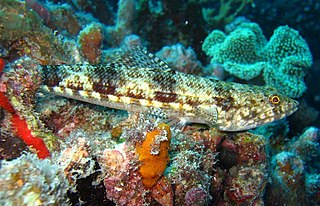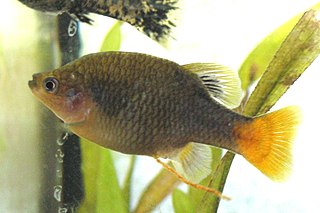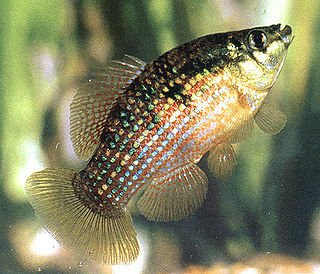
Cyprinidae is a family of freshwater fish commonly called the carp or minnow family, including the carps, the true minnows, and their relatives the barbs and barbels, among others. Cyprinidae is the largest and most diverse fish family, and the largest vertebrate animal family overall, with about 3,000 species; only 1,270 of these remain extant, divided into about 200 valid genera. Cyprinids range from about 12 mm (0.5 in) in size to the 3 m (9.8 ft) giant barb. By genus and species count, the family makes up more than two-thirds of the ostariophysian order Cypriniformes. The family name is derived from the Greek word kyprînos.

Cyprinodontiformes is an order of ray-finned fish, comprising mostly small, freshwater fish. Many popular aquarium fish, such as killifish and live-bearers, are included. They are closely related to the Atheriniformes and are occasionally included with them. A colloquial term for the order as a whole is toothcarps, though they are not actually close relatives of the true carps – the latter belong to the superorder Ostariophysi, while the toothcarps are Acanthopterygii.

Characidae, the characids or characins, is a family of freshwater subtropical and tropical fish belonging to the order Characiformes. The name "characins" is a historical one, but scientists today tend to prefer "characids" to reflect their status as a, by and large, monophyletic group. To arrive there, this family has undergone much systematic and taxonomic change. Among those fishes remaining in the Characidae currently are the tetras, comprising the very similar genera Hemigrammus and Hyphessobrycon, as well as a few related forms, such as the cave and neon tetras. Fish of this family are important as food in several regions, and also constitute a large percentage of captive freshwater aquarium fish species.

Cypriniformes is an order of ray-finned fish, which includes many families and genera of cyprinid fish, such as barbs, gobies, loaches, botias, and minnows. Cypriniformes is an "order-within-an-order", placed under the superorder Ostariophysi—which is also made up of cyprinid, ostariophysin fishes. The order contains 11–12 families, over 400 genera, and more than 4,250 named species; new species are regularly described, and new genera are recognized frequently. Cyprinids are most diverse in South and Southeast Asia, but are entirely absent from Australia and South America. At 112 years old, the longest-lived cypriniform fish documented is the bigmouth buffalo.

Aulopiformes is a diverse order of marine ray-finned fish consisting of some 15 extant and several prehistoric families with about 45 genera and over 230 species. The common names grinners, lizardfishes and allies, or aulopiforms are sometimes used for this group. The scientific name means "Aulopus-shaped", from Aulopus + the standard fish order suffix "-formes". It ultimately derives from Ancient Greek aulós + Latin forma, the former in reference to the elongated shape of many aulopiforms.

Goodeidae is a family of teleost fish endemic to Mexico and some areas of the United States. Many species are known as splitfins. This family contains about 50 species within 18 genera. The family is named after ichthyologist George Brown Goode (1851–1896).

The flagfish, also known as the American flagfish or Florida flagfish, is a species of pupfish, a type of killifish from the family Cyprinodontidae which is endemic to Florida. It is found in the aquarium trade. Its common name derives from the dominant males' body pattern, which bears some resemblance to the Flag of the United States.
The striped goodeid, bluetail goodeid or bluetail goodea is an endangered species of fish in the family Goodeidae. Its genus Ataeniobius is monotypic. It is endemic to the Río Verde and associated waters, including the Media Luna and Los Anteojitos lakes, in San Luis Potosí, Mexico. The specific name of this fish honours its discoverer, the America evolutionary biologist William Lawrence Tower (1872–1955) of the University of Chicago.
Blackfin pupfish is a species of fish in the family Cyprinodontidae. This pupfish is endemic to Lake Chichancanab in Quintana Roo, Mexico. In almost all places, different Cyprinodon species do not overlap in their range, but there are two notable exceptions and one of these is Lake Chichancanab, which is inhabited by C. beltrani, C. esconditus, C. labiosus, C. maya, C. simus, C. suavium and C. verecundus. Among the endemic Cyprinodon species in Lake Chichancanab, only C. beltrani and C. labiosus still occur in some numbers in their habitat, while the remaining are virtually—if not fully—extinct in the wild. This species feeds on detritus. Compared to the other species of pupfish mentioned previously, the C. beltrani prefer a different feeding substrate. In regards to mating, the female blackfin pupfish seems to mate with other species of pupfish and not just the C. beltrani. The male blackfin pupfish have similar markings and courting behaviors to other pupfish in their habitat. The person honored in the specific name of this pupfish is the Mexican biologist Enrique Beltrán Castillo (1903–1994) to mark his quarter century of being a biologist.

The Balsas splitfin is a species of fish in the family Goodeidae. It is endemic to Mexico where it occurs in the states of Morelos and Michoacán. This fish was formally described as Goodea whitei by Seth Eugene Meek in 1904 with the type locality given as Yautepec in Morelos. The specific name honours E. A. White of the Interoceanic Railway of Mexico for his interest in and support of Meek's work.
Valencia letourneuxi, the Corfu toothcarp, is a species of fish in the family Valenciidae. It is found in Albania and Greece. Its natural habitats are rivers, freshwater marshes, freshwater spring, and coastal saline lagoons. It is threatened by habitat loss. The specific name of this fish honours the collector of the type, the botanist Aristide-Horace Letourneux (1820-1890). The species was described as Fundulus letourneuxi in 1880 by Henri Émile Sauvage with a type locality of Cressida, Corfu. It also formerly occurred on the island of Lefkas but is now considered to be extirpated from both there and Corfu. Valencia letourneuxi is a highly endangered freshwater species that faces threats from habitat degradation, water abstraction, and foreign species. While little is known of its ecological history, V. Letourneuxi produce 2.2 mm eggs during the spring on aquatic plants in stagnant water that has a lot of vegetation.

The Gobiiformes are an order of fish that includes the gobies and their relatives. The order, which was previously considered a suborder of Perciformes, is made up of about 2,211 species that are divided between seven families. Phylogenetic relationships of the Gobiiformes have been elucidated using molecular data. Gobiiforms are primarily small species that live in marine water, but roughly 10% of these species inhabit fresh water. This order is composed chiefly of benthic or burrowing species; like many other benthic fishes, most gobiiforms do not have a gas bladder or any other means of controlling their buoyancy in water, so they must spend most of their time on or near the bottom. Gobiiformes means "goby-like".

The Pseudocrenilabrinae are a subfamily in the cichlid family of fishes to which, according to a study from 2004, includes all the Middle Eastern and African cichlids with the exception of the unusual Heterochromis multidens and the Malagasy species. This subfamily includes more than 1,100 species. Previous authors recognized additional African subfamilies, e.g. the Tilapiinae of Hoedeman (1947), Tylochrominae of Poll (1986), or Boulengerochrominae of Tawil (2001).

Goodeinae is a subfamily of splitfins from Mexico, part of the family Goodeidae. They are small fish which mostly live in fresh water, especially around Mesa Central, west of Mexico City. Members of the subfamily are also found in brackish water on both the east and west coasts. They typically have small ranges and many are seriously threatened. The subfamily takes its name from its type genus Goodea and so is ultimately named after the American ichthyologist George Brown Goode (1851-1896).

Profundulus is a genus of fish in the family Profundulidae endemic to Mexico and northern Central America. It was regarded as the only genus in the Profundulidae but workers have split the genus and raised a second genus Tlaloc.

Alloherpesviridae is a family of viruses in the order Herpesvirales. This family includes the species that infect fish and amphibians. Phylogenetic studies have confirmed the validity of this family and suggest that it may be divided into two clades: one consisting of viruses from cyprinid and anguillid hosts and the other of viruses from ictalurid, salmonid, acipenserid, and ranid hosts. There are currently 13 species in this family, divided among four genera. A disease associated with this family includes channel catfish disease.

Tlaloc is a genus of fish in the family Profundulidae endemic to Mexico, Guatemala and Honduras. The genus is not, however, recognised by Fishbase or in the 5th Edition of Fishes of the World. The genus is named for Tlaloc the water god of the Aztecs.

The Anabantiformes, is an order of bony fish (Teleostei) proposed in 2009. They are collectively known as labyrinth fish, are an order of air-breathing freshwater ray-finned fish with two suborders, five families and at least 207 species. In addition, some authorities expand the order to include the suborder Nandoidei, which includes three families - the Nandidae, Badidae and Pristolepididae - that appear to be closely related to the Anabantiformes. The order, and these three related families, are part of a monophyletic clade which is a sister clade to the Ovalentaria, the other orders in the clade being Synbranchiformes, Carangiformes, Istiophoriformes and Pleuronectiformes. This clade is sometimes referred to as the Carangaria but is left unnamed and unranked in Fishes of the World. This group of fish are found in Asia and Africa, with some species introduced in United States of America.

Ovalentaria is a clade of ray-finned fishes within the Percomorpha, referred to as a subseries. It is made up of a group of fish families which are referred to in Fishes of the World's fifth edition as incertae sedis, as well as the orders Mugiliformes, Cichliformes, and Blenniiformes. It was named by W. L. Smith and T. J. Near in Wainwright et al. (2012) based on a molecular phylogeny, but the authors suggested that the group was united by the presence of demersal eggs that are attached to a substrate. Some authors have used the ordinal name Stiassnyiformes for a clade including Mugiloidei, Plesiopidae, Blenniiformes, Atherinomorpha, and Cichlidae, and this grouping does appear to be monophyletic.

Cyprinodontoidei is a suborder of fishes, one of the two suborders in the order Cyprinodontiformes. The Cyprinodontoidei consists of four superfamilies which are found in the Americas, the Mediterranean and in Africa, including Madagascar.

















